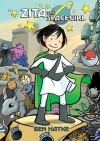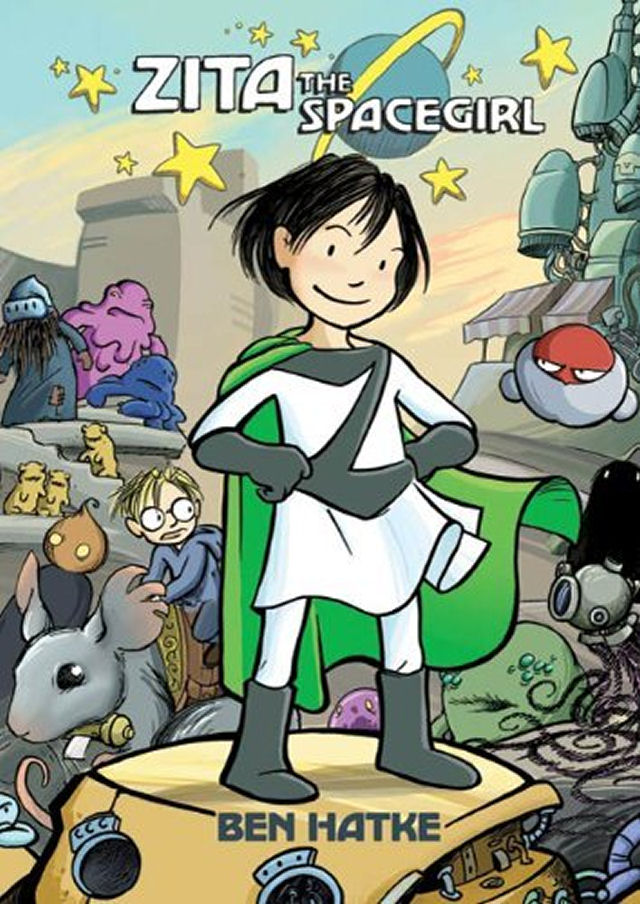 The Plot
The Plot
Zita and her friend Joseph are on their way home from school when a meteor crashes nearby. Upon finding a mysterious red button concealed within the meteorite, Zita naturally wants to press it — and press it she does. After this results in Joseph being kidnapped by aliens, Zita finds her courage and goes after him, knowing that she may be his only chance of getting home again.
My Thoughts
First impressions are key, they say, and this graphic novel makes a marvelous first impression. The book is in full, vibrant color and composed of sturdy, thick paper pages which not only don’t bleed through, but which look and feel like they’ll stand up very well to small hands and repeated readings.
Zita manages to live up to the great first impression. The artwork, a pleasing mixture of cute and weird, manages somehow to present a detailed and exciting setting while still remaining simple enough that the panels never feel cluttered and the characters overpowered by the backgrounds. As the story got underway, part of me couldn’t help trying to picture how the graphic novel would translate to a movie — and if said movie should be animated by Studio Ghibli or done in live action by the Jim Henson Company. (Sorry, Disney-Pixar, I don’t think you could handle it.)
The story itself is straightforward: girl in a strange land collects a group of rag-tag misfits and heads off to find the wizard summon one of the four gods rescue her friend, but it’s very well-done and effectively told through the artwork and dialogue. I was hooked from the beginning, when Zita and her friend Joseph encounter the meteorite (called a meteoroid in the text, which I’m pretty sure is only what they’re called when they’re still in space) and the mysterious red button. Joseph’s abrupt abduction leads to easily the most realistic reaction I’ve seen in a long time: Zita panics and runs away. But she masters her fears and comes back again, making her effort to rescue him clearly much more considered (and brave!) than a story in which she impulsively and recklessly leapt through the portal right away.
I really had only one major problem with this work. It didn’t affect my enjoyment of it, but it’s not a minor concern, either. It is this: after I finished the book, I sat back with a feeling of vague confusion. I could not remember a single identifiably female character other than Zita — not just among the named characters, but even as scenery in the background*. Then I wondered why I remembered all of the other named characters as male. Some of them were robots, and surely they weren’t assigned a gender? So I went back through the book again, and as it turns out, my impression was unfortunately correct. Not only is Zita the only identifiably female character in the book, every other named character (with the exception of Strong-strong) is referred to with a male pronoun.
I was shocked by this. Was this an oversight on the author’s part, or a conscious decision? Either way, it doesn’t look good. The default gender in the universe should not be ‘male’. Unfortunately, this is pretty common in properties which are aimed toward a cross-gender or male market — but that doesn’t make it okay, less offensive, or less obvious to girls that they’re being dissed. (I was one of those girls, and marketing people can say all they like about girls being willing to watch/read/enjoy things with boy characters — it may be true but we NOTICE.)
The book is good, and I’d like to see more. I can’t give author Ben Hatke a ‘bye’ for this, but I can hope he will strive to provide a more gender diverse cast in any future Zita installments.
*Toward the end, there appears to be an extremely random cameo by Marzipan, but I don’t know if I want to count that.
In Short
Zita the Spacegirl is fantastic. As a character, Zita is believable, interesting and charismatic. The artwork supports the story perfectly, and makes it feel like a movie even while remaining still on the page. I’ll certainly be purchasing a copy of my own, and I’ll probably be recommending that the library purchase it as well. The one major flaw in this work is an egregious gender imbalance, with Zita being the only female character I was able to identify in the entire book — I’m hopeful this is something the author will correct in future installments.
A review copy of Zita the Spacegirl was provided by the publisher.


It’s funny; on page 24 of Zita there is a pursecarrying monster who tells Zita to “watch it!”, and as I was reading the story I appreciated that a big hairy monster lady would carry a pink-flowered purse. Everything after that, though, is pretty male-centric (aside from the protagonist.).
That sort of thing unsettles me, too. To the extent that I got really annoyed at the whimsical little humor book “All My Friends Are Dead”, cause, sure they’re all funny little comics, but everything that is a “person” is a white dude. The whooooole book through.
I’ll have to go back and check out the monster-with-purse. If there were more bits like that in the background… Well, I was going to say, it might not be so glaringly obvious the lack of gender diversity in the main cast, but nothing would have made that less problematic than fixing it.
The white dude thing really grates. Getting back to Zita, I wondered why Piper was a white dude. There seemed no particular reason he needed to be one. He could just as easily have been brown or Asian or female or heck, purple.
Doh! I totally didn’t notice that all of the rest of the characters were male. When I came to that part of your review, my first thought was definitely ‘but.. the robots aren’t anything, and the mouse is a mouse and…’ But you’re right, of course, inevitably they got called by a male pronoun. Grr.
If he is the Pied Piper, then that would be a reason for him being white. But he’s probably not, so, yea. Zita herself read white to me, but you could easily look at her and think Asian or Hispanic. But Joseph is definitely white, and their skin tone seems to be the same shade.
Oh, and I vote for Ghibli, though Henson would be good too. :)
It was really the chickens that made me think of Henson. But they do a lot of things very well.
The whole male business makes me more sad the more I think on it, because I liked the book so much that it disturbs me there’s this giant flaw in it.
Yea. I wish you hadn’t pointed it out!!
I love your comments about how the artwork manages to be both detailed and yet simple enough not to feel cluttered. I also admired how consistent it is. One of the things that turns me off about Western comics—and here I mostly mean the floppy variety—is how characters’ faces can alter from page to page. Hatke doesn’t have that problem.
Also, my vote’s for Studio Ghibli!